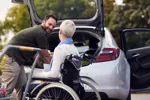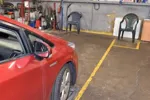The insurer funded research centre unveiled three new safety systems at a major European media conference held today at its Transport Research Laboratory in Berkshire.
The systems mitigate and in some cases prevent low speed shunts and collisions – the most common type of accident – which creates billions of pounds worth of damage to vehicles, motorists and their passengers. This type of accident makes up 75% of all motor accidents.
Thatcham has been evaluating three different systems:
The Volvo City Safety
This system will be fitted as standard to Volvo’s XC60 which will be on sale from November. The system is active at up to 20 mph and uses a form of laser radar (LIDAR) mounted in top of the windscreen. It is programmed to respond if the vehicle in front is either at a standstill or is moving in the same direction as the car itself.
The brakes are pre-charged and should a collision be imminent it applies them and cuts the throttle. If the car is travelling below 10mph it should prevent the collision entirely and at a speed of up to 20 mph will reduce the impact by 50%.
The Mercedes Distronic Plus
This system is currently available on some S-class models. It uses two radar systems linked to the car’s cruise control system to maintain a safe distance between the driver and the car in front. It provides a continual calculation of the distance between the vehicle in front and the speed differential between them and will bring the car to a complete stop if necessary.
The Honda CMBS
This system is currently on the CR-V and uses a radar system that again calculates the distance and the speed differential with the vehicle in front.
Should this become out of kilter the driver receives visual and audible warnings before brakes are progressively activated. Seat belts are also tightened to alert the driver of an impending problem and lessen any resulting injuries.
Matthew Avery, Thatcham research manager, said: “These systems are a massive breakthrough for keeping motorists safe. Vehicle manufacturers should be congratulated for developing and introducing this technology which is significant for the safety of all UK road users.
“It will take a number of years before enough cars in the UK ‘car parc’ are fitted with the technology – but once a threshold is reached injury figures will tumble.”
However, Avery said it was imperative that driver vigilance is not lowered by inclusion of the new systems in new models.
He added: “These systems should not allow the driver to compensate – and take additional risks. The car is not the driver – the driver drives the car. This is just the beginning of the collision avoidance revolution. We will see systems that can detect pedestrians and other vulnerable road users and even steer the car to avoid a crash.”














Login to comment
Comments
No comments have been made yet.